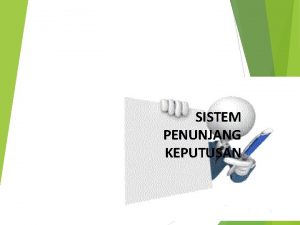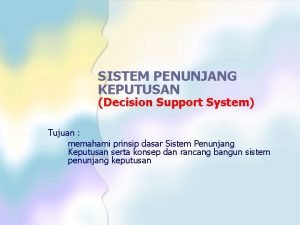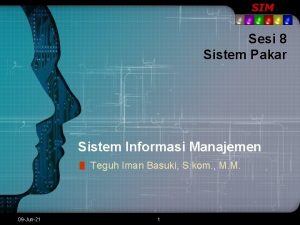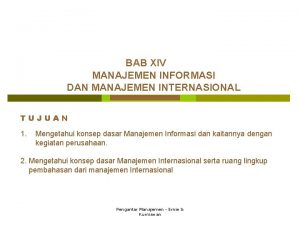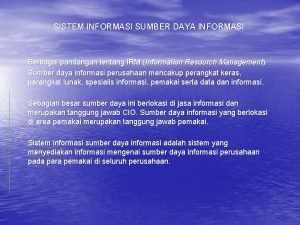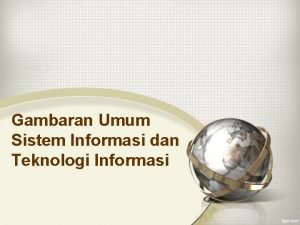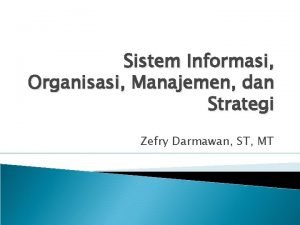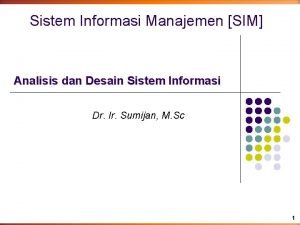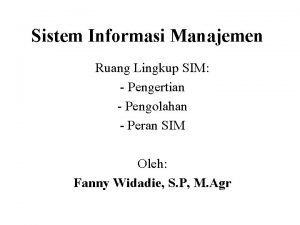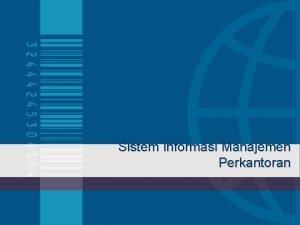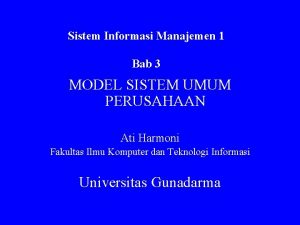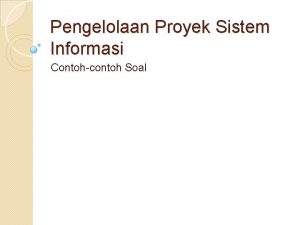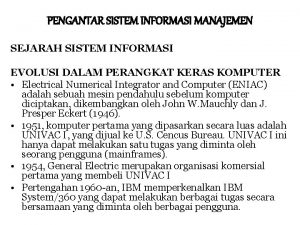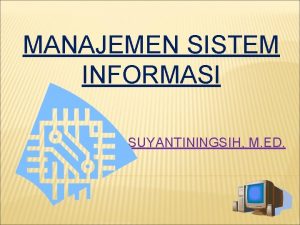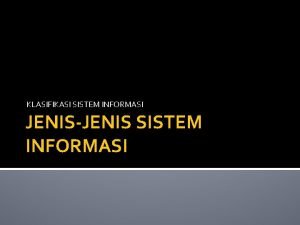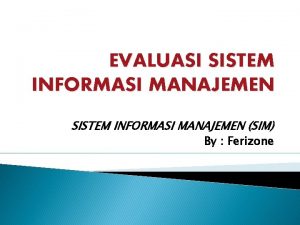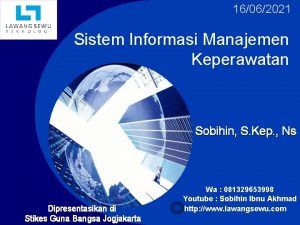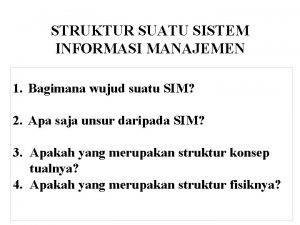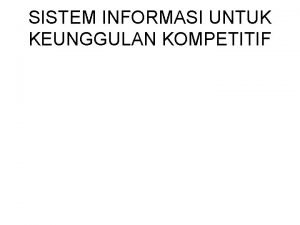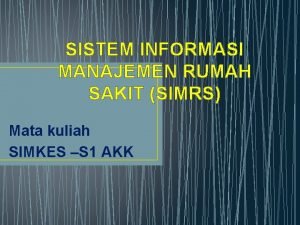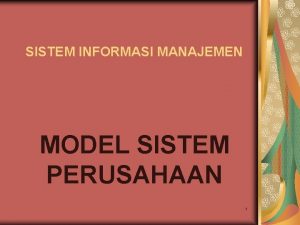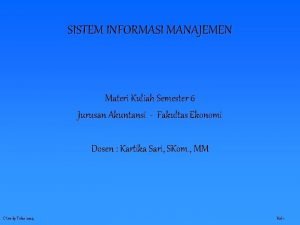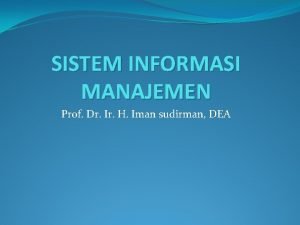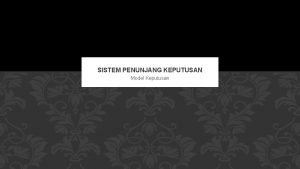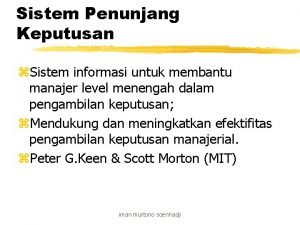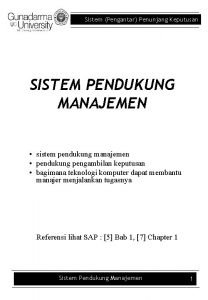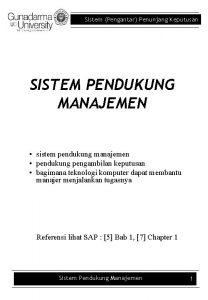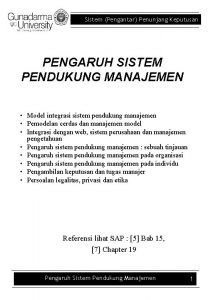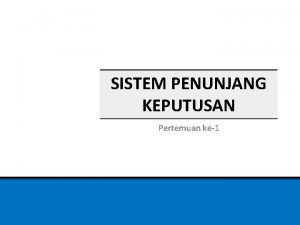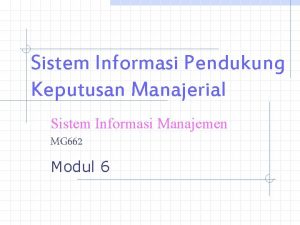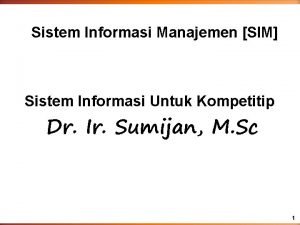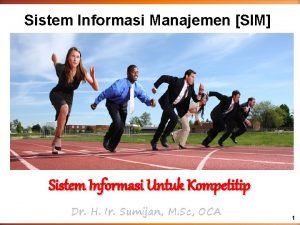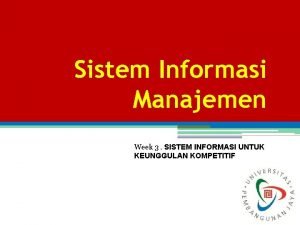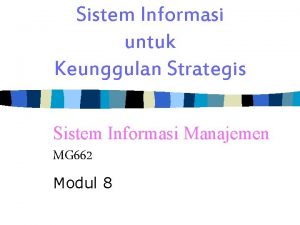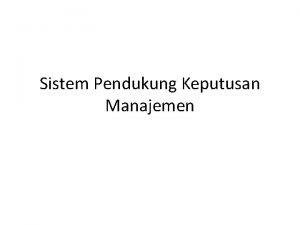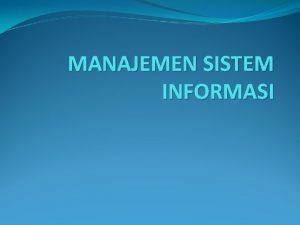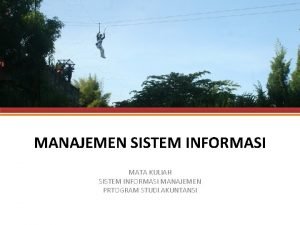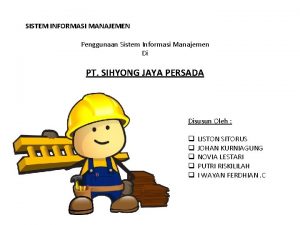SISTEM PENUNJANG KEPUTUSAN UNTUK SISTEM INFORMASI MANAJEMEN Fanny


























- Slides: 26

SISTEM PENUNJANG KEPUTUSAN UNTUK SISTEM INFORMASI MANAJEMEN Fanny Widadie, SP, M. Agr

Manajer sebagai Pengguna Sistem Informasi �Manajer berada pada berbagai tingkatan manajerial dan dengan berbagai area bisnis perusahaan �Pada tingkatan mana IS dikembangkan untuk memberikan pengaruh bagaimana IS dapat beroperasi (lihat gambar) �Tiga tingkatan utama manajemen: 1. Tingkat Perencana Strategis 2. Tingkat Pengendali Manajemen 3. Tingkat Pengendali Operasi 2

3


Peran Manajer �Fungsi Manajemen : ◦ Plan (Perencanaan) ◦ Organize (Pengorganisasian) ◦ Staff (Penyusunan Staf) ◦ Direct (Pengarahan) ◦ Control (Pengendalian) (Gb 1. 13) �Peran Manajerial: ◦ Kerangka Mintzberg’s dibentuk dari 10 peran yang dimainkan para manajer, mengelompokkan ke dalam hubungan antar pribadi, informasi, dan aktivitas-aktivitas pembuatan keputusan (lihat Table 1. 1) 5


Three Main Categories of Information Systems 1. Operational-level systems 2. Management-level systems 3. Strategic-level systems

Four Major Types of Systems 1. Transaction Processing Systems (TPS) 2. Management Information Systems (MIS) 3. Decision-Support Systems (DSS) 4. Executive-Support Systems (ESS)


Transaction Processing Systems (TPS) Basic business systems that serve the organization’s operational level Input: Transactions, events Processing: Sorting, listing, merging, updating Output: Detailed reports, lists, summaries Users: Operations personnel, supervisors

A symbolic representation for a payroll TPS

Typical applications of TPS

Four Major Types of Systems Management Information Systems (MIS) Serve management level; provide reports and access to company data Input: Summary transaction data, high-volume data, simple models Processing: Routine reports, simple models, low-level analysis Output: Summary and exception reports Users: Middle managers

How management information systems obtain their data from the organization’s TPS

A sample report that might be produced by the MIS in Figure 2 -5

Decision-Support Systems (DSS) Serve management level with data analysis for making decisions Input: Low-volume data or massive databases, analytic models, and data analysis tools Processing: Interactive, simulations, analysis Output: Special reports, decision analyses, responses to queries Users: Professionals, staff managers

Voyage-estimating decision-support system

Executive Support Systems (ESS) Provide communications and computing environment that serves the organization’s strategic level Input: External and internal aggregate data Processing: Graphics, simulations, interactive Output: Projections, responses to queries Users: Senior Managers

Model of a typical executive support system

Interrelationships among systems

Systems from a Functional Perspective Major Business Functions Sales and Marketing Systems 2. Manufacturing and Production Systems 3. Finance and Accounting Systems 4. Human Resource Systems 1.

Systems from a Functional Perspective Sales and Marketing Systems � � � Help identify customers Develop products and services Promote products and services Sell products and services Provide ongoing customer support

Systems from a Functional Perspective Table 2 -2: Examples of Sales and Marketing Information Systems System Description Organizational Level Order processing Enter, process, and track orders Operational Pricing analysis Determine prices for products and services Management Sales trend forecasting Prepare 5 -year sales forecasts Strategic

Manufacturing and Production Systems Planning, development, production of products and services Planning, development, maintenance of production facilities Acquisition, storage, availability of materials Scheduling materials, facilities, labor Controlling the flow of production

Table 2 -3: Examples of Manufacturing and Production Information Systems System Description Organizational Level Machine control Control the actions of machines and equipment Operational Production planning Decide when and how many products should be produced Management Facilities location Decide where to locate Strategic new facilities

 Sistem pengambil keputusan
Sistem pengambil keputusan Tujuan dari sistem pendukung keputusan
Tujuan dari sistem pendukung keputusan Sistem pakar dalam sistem informasi manajemen
Sistem pakar dalam sistem informasi manajemen Manajemen informasi dan manajemen internasional
Manajemen informasi dan manajemen internasional Pohon keputusan contoh
Pohon keputusan contoh Sumber daya informasi adalah
Sumber daya informasi adalah Gambaran sistem
Gambaran sistem Structure of management information system
Structure of management information system Sistem informasi organisasi manajemen dan strategi
Sistem informasi organisasi manajemen dan strategi Desain sistem informasi manajemen
Desain sistem informasi manajemen Model tiga lingkup kegiatan manajemen sistem
Model tiga lingkup kegiatan manajemen sistem Sistem informasi perkantoran
Sistem informasi perkantoran Model model sistem informasi manajemen
Model model sistem informasi manajemen Soal uts manajemen proyek sistem informasi
Soal uts manajemen proyek sistem informasi Sejarah sistem informasi manajemen
Sejarah sistem informasi manajemen Alur sistem informasi manajemen
Alur sistem informasi manajemen Contoh klasifikasi informasi
Contoh klasifikasi informasi Tujuan dilakukan evaluasi sistem informasi manajemen
Tujuan dilakukan evaluasi sistem informasi manajemen Logo sistem informasi manajemen
Logo sistem informasi manajemen Wujud sistem informasi manajemen
Wujud sistem informasi manajemen Sistem informasi manajemen sebagai keunggulan kompetitif
Sistem informasi manajemen sebagai keunggulan kompetitif Sistem informasi personalia
Sistem informasi personalia Komponen utama sistem informasi manajemen rumah sakit
Komponen utama sistem informasi manajemen rumah sakit Pengertian sistem informasi rumah sakit
Pengertian sistem informasi rumah sakit Model sistem informasi manajemen
Model sistem informasi manajemen Rangkuman mata kuliah sistem informasi manajemen
Rangkuman mata kuliah sistem informasi manajemen Sistem informasi manajemen 1970
Sistem informasi manajemen 1970
